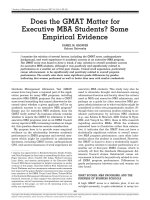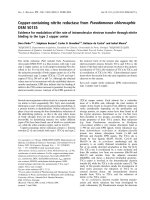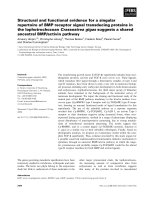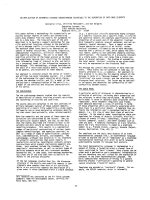The Effectiveness of Antidumping Measures under the Byrd Amendment: Some Empirical Evidence for Catfish
Bạn đang xem bản rút gọn của tài liệu. Xem và tải ngay bản đầy đủ của tài liệu tại đây (1.37 MB, 18 trang )
The Effectiveness of Antidumping
Measures under the Byrd Amendment:
Some Empirical Evidence for Catfish
Nguyen Minh Duc and Henry Kinnucan
Auburn University, AL, USA
NMDUC2009
INTRODUCTION
•
Globalization benefits all, all countries, all people and all trade partners
(Thompson)
•
Through various GATT/WTO rounds, tariff barriers have decreased
worldwide, but anti-dumping measurement has surged to play a crucial role
as the most important non-tariff barrier (Zanardi, 2004).
•
Antidumping duty (AD) is recently used more frequently, by more
countries, and against more products (Prusa, 2005)
•
As processed and differentiated agricultural products are increasingly
traded cross national borders (Reimer and Stiegert, 2006) more of them are
facing antidumping measurements conducted by importing countries
•
Recently, aquatic products trade has the same problem
NMDUC2009
1
THIS STUDY
•
As US food processing and distribution is often marked by product
differentiation and imperfect competition (Cornor et al., 1985 and Sexton
2000), the theoretical framework assumes Bertrand competition and
differentiated goods.
•
Under “labeling” law 2001 and biological differentiation of the catfish
products, “catfish war” is useful for a study case on effect of the
antidumping tariff for differentiated products.
•
In the empirical regression, price-reaction functions are derived and
estimated jointly with a demand equation using monthly data for the period
January 1999-August 2006 to test whether US price and quantity increased
during the tariff period, as predicted by theory.
NMDUC2009
CASE STUDY – CATFISH WAR
v Catfish production is one of the biggest aquaculture industries in the US and
frozen catfish fillets is the most important product of the US catfish processing
industry (Harvey, 2005).
v The anti-dumping duties are large (ranging from 44.66% to 63.88%) affected all
of the fisheries processing companies in Vietnam that export to the US and were
implemented in 2003, two years after the Byrd Amendment went into force.
v Disbursement paid to processors of $9.2 million in two fiscal years of 2005-2006,
or 3% of their 2005 sales revenue of frozen catfish fillet.
v The case attracted substantial media attention with articles in the New York Times
and Wall Street Journal focusing the ethical and policy dilemmas raised by the
action.
NMDUC2009
2
Table 3. Imports, Production and Prices of US Catfish Industry 1999-2005
1999
2000
2001
2002
2003
2004
2005
1.99
7.04
17.12
9.62
4.25
6.57
17.42
US frozen fillets production
(mil.lb.)
119.92
119.65
115.16
131.27
124.70
121.80
123.68
US Farm Production (mil. lb.)
596.63
593.60
597.11
630.60
661.47
630.45
600.67
F.o.b Vietnam price ($/lb)
2.04
1.52
1.26
1.29
1.21
1.15
0.93
US frozen fillets price ($/lb)
2.76
2.83
2.61
2.39
2.41
2.62
2.67
73.75
75.22
64.81
56.86
58.17
69.75
72.36
Frozen fillets imports from VN
(mil. lb.)
Farm price (cent/lb.)
NMDUC2009
HYPOTHESES
•
Anti-dumping duties tend to be ineffective as most of the duty is borne by
the foreign supplier rather than the importing-country consumer (Kinnucan,
2003).
•
The Byrd Amendment has the paradoxical effect of increasing the value
and total volume of imports (Evenett, 2006) and undermines the original
intent of the duty because it gives an incentive for the domestic firm to
increase its price for an increase in the sales of the foreign firm, which
increases the domestic firm’s revenue from the tariff.
NMDUC2009
3
LITERATURE REVIEW
Imperfect Competition in Agricultural International Trade
• International markets of some other commodities:
– Buschena and Perloff (1991): Philippines takes substantial market
power in the coconut oil exports market
– Pick and Park (1991), Patterson and Abbott (1994): evidence for
price discrimination and market power by US wheat exporters.
– Karp and Perloff (1993): Brazil and Columbia are oligopolistics in
coffee export market
– Deodhar and Sheldon (1996): German banana import market
follows Cournot-Nash equilibrium
– Dong, Marsh and Stiegert (1996): the global malting barley market
operates as a Cournot quantity setting oligopoly.
– Carter and MacLaren (1997) US and Australian beef exporters
follows the Stackerberg model with price leadership by Australians.
NMDUC2009
350.0
300.0
250.0
Fob VN Price
US Price
Farm Price
200.0
150.0
100.0
Jan-06
May-06
Sep-05
May-05
Jan-05
Sep-04
Jan-04
May-04
Sep-03
Jan-03
May-03
Sep-02
May-02
Jan-02
Sep-01
Jan-01
May-01
Sep-00
Jan-00
May-00
Sep-99
May-99
0.0
Jan-99
50.0
Prices of frozen catfish fillets
NMDUC2009
4
LITERATURE REVIEW
Imperfect Competition in Agricultural International Trade
•
•
•
Reimer and Stiegert, 2006: a large number of the competitive behaviors
in specific agricultural products have been documented.
Rice export markets:
– Karp and Perloff (1989): Thailand, Pakistan and China are
oligopolists and all other countries as a competitive fringe
– Yumkella, Unnevehr and Garcia, (1994): US and Thailand
competitive behaviors are also imperfect.
Food and beverage export market
– Glauben and Loy (2003): there are exercises of market power by
German export of beer to North America, in exports of sugar
confectionery to the UK and in exports of cocoa powder to Italy.
– Wilhelmsson (2006): Swedish food and beverage industry do enjoy
some varied degrees of market power which is decreased with foreign
competition
NMDUC2009
Vietnamese catfish industry globalizes…
•
•
•
•
•
Vietnamese catfish industry has considerably developed since the country
joined into globalization and adopted free trade principles (Cohen and
Hiebert, 2001)
employed almost a half of million Vietnamese people (Narog, 2003).
Vietnamese producers successfully created low-cost breeding techniques of
catfish in 1998 and developed a catfish breeding industry involving 15,000
families (Kuntzman, 2003)
VN catfish farmers have opted to buy high protein pellet feed from an
American company, Cargill (Cohen and Hiebert, 2001; Sengupta, 2003)
and also adopted advanced feeding technologies to improve fish meat
quality, meeting the quality and taste requirements of US consumers.
VN catfish processors have learned catfish fillet techniques from an
Australian importer and used processing equipments purchased from the
US for their production (Cohen and Hiebert, 2001), following the quality
control protocols of HACCP and Good Aquaculture Practice (GAP)
recommended by US FDA.
NMDUC2009
5
…to export…
•
•
Since 1998 with membership in APEC, Vietnamese fisheries export to US
increased extremely, especially in catfish sales, from 0.6 million pound in
1998 to 17 million pound in 2001.
Although exporting catfish even before 1995, when the official embargo on
Vietnamese exports was lifted by the US, the tremendous spurt in exports to
US came in 1999 when raw seafood tariffs dropped to zero and reached a
volume of 18.3 million kilograms of catfish to the US, which is valued at $55.1
million in 2002 (Sengupta, 2003) after the bilateral trade agreement between
US and Vietnam was signed in December 2001.
NMDUC2009
…and threaten the US catfish industry…
• With similarity of texture and taste but lower price, the “most
similar product in characteristics and uses” (ITC, 2002),
Vietnamese catfish was beginning to threaten the US catfish
growers and wholesalers when 90% of the catfish imported by
US in 2000 came from Vietnam (Cohen and Hiebert, 2001).
• Catfish production is the biggest aquaculture industry in the
United State and frozen catfish fillet is the most important
product of the US catfish processing industry (Harvey, 2005).
In 2005, 124 million pounds of frozen catfish fillet was sold by
domestic processors, increasing 1.5% relative to 2004 (Harvey,
2006).
NMDUC2009
6
…leading to the catfish war
Catfish raised popularly in southern states of US are Ictaluridae family, mostly channel
catfish (Ictalurus punctatus) and blue catfish (Ictalurus furcatus) farmed in closed
ponds
Vietnamese catfishes are basa (Pangasius bocourti) and tra (Pangasius pangasius)
belong to Pangasius family and cultured popularly in cages and pens along the
Mekong River.
•
First step: the US Congress passed a law in 2002 restricting the use of the word
“catfish” for labeling to only those Ictaluridae varieties farmed in US (Narog, 2003)
•
The second step is lobbying for renegotiation of the 2001 bilateral trade agreement
between US and Vietnam to set limits on catfish imports (Cooper, 2001)
•
The third is antidumping suit filed by US producers in 2002 that led to tariffs
ranging from 44.66% to 63.88% levied on frozen fillet catfish imported from
Vietnam, starting from January 2003.
•
The war is still continuing with non-tariff barriers as “Sales Ban” orders in 2005 in
Alabama, Mississippi and Louisiana
NMDUC2009
LITERATURE REVIEW
Antidumping measurement – definition and investigation process
What does “dumping” mean?
There are two criteria in WTO regulations (Knetter and Prusa, 2000):
- First, there must be evidence that the domestic industry has materially injured
(e.g., a loss or decline in profitability) by foreign imports
- Second, the foreign suppliers must be found to be selling their products at
dumping prices
A dumping case occurs when subject products are sold at a price “less than fair value”
(LTFV).
LTFV criterion can be determined in either of two ways:
(1) by showing that the price charged in the domestic market by the foreign suppliers
is below the price charged for the same product in other markets (i.e., the “pricebased” method)
(2) by showing that the price charged in the domestic market is below an estimate of
cost plus a normal return (i.e., the “constructed-value” method).
NMDUC2009
7
LITERATURE REVIEW
Antidumping measurement – definition and investigation process
In US, the Department of Commerce (DOC) and the International Trade
Commission (ITC) administrate the antidumping laws. Each has distinct roles in the
antidumping investigation process.
Blonigen and Haynes (2002): Exporters react to avoid or reduce the duty by raising
their price prior to and during the long process of investigation
Time line of standard US Antidumping Investigation (Source: Blonigen and Heynes, 2002)
NMDUC2009
Incidence of a tariff
Assume: US and VN catfish fillets are substitute goods in US market
P
P
Su
Sv
Pu
Pv*
Du
Qu
US catfish fillets
Q
NMDUC2009
Catfish
Dv
Q
fillets import from Vietnam
8
Incidence of a tariff
An antidumping tariff T imposed on VN catfish fillets raises home price and output
S’v
P
P
Su
T
P’u
Pv
Pu
Sv
d
Pv*
Pvs
Du
D’u
Q
QuQ’u
Dv
Q
NMDUC2009
US catfish fillets
Catfish fillets import from Vietnam
Incidence of a tariff
If import demand is perfect elastic, no effect on home product.
Sv
P
P
Su
T
Pu
Pv*
Sv
Dv
Pvs
Du
Qu
US catfish fillets
Q
NMDUC2009
Catfish
Q
fillets import from Vietnam
9
Incidence of an antidumping tariff with Byrd Amendment
Byrd effect can offset the tariff effect on home price in perfect competition
P
Su
S’u
Byrd effect
P’u
Pu
Tariff effect
D’u
Du
Q
Qu Q’u Q”u
NMDUC2009
US catfish
Negative effect of a tariff in a Bertrand competition
Best reaction functions of domestic and import catfish from Vietnam
Pvn
R’vn
Rvn
(8)
Rus
R’us
(11)
Rvn: Pvn=f(Pus)
R’us : Pus=f(Pvn)
P*2
P*’2
Tariff effect
P*’2 - t
Byrd effect
P*’’2
P*’’1 P*’ P*1
1
Pus
NMDUC2009
10
THEORETICAL FRAMEWORK
Bertrand Competition
Q1 be the quantity sold in the home market by the home firm at price P1
Q2 be the quantity sold in the home market by the foreign firm at price P2
Q1 = α 1 − β1 P1 + γ 1 P2
Q2 = α 2 − β 2 P2 + γ 2 P1
βi > 0
γi ≥ 0
The degree of substitutability between Q1 and Q2 is given by 0 <
γ 1γ 2
< 1
β 1β 2
To protect the home firm, a tariff equal to t is imposed on each unit of sales by
the foreign firm.
P2 = P2− + t
P2− is the f.o.b price received by the foreign seller
t is the per-unit dumping duty.
NMDUC2009
THEORETICAL FRAMEWORK
Bertrand Competition
Q21 = α 2 − β 2 P2 + γ 2 P1 quantity sold by the foreign firm in the home market
Q22 = α 3 − β 3 P3
quantity sold in alternative export markets
Q 2 = Q21 +Q 22 is the foreign firm’s total exports
With the Byrd subsidy for the US firm, profit functions for the home and foreign firms
π 1 = ( P1 −C1 )Q1 + ϕ t Q21
π 2 = ( P 2 −C 2 − t )Q21 + ( P3 − C3 )Q22
C1 is the home firm’s constant marginal cost
φ <1 is a parameter indicating the firm’s share of the total duties collected
C2 and C3 are the foreign firm’s per-unit marginal cost of supplying the two markets
NMDUC2009
11
THEORETICAL FRAMEWORK
Bertrand Competition
profit maximization for both firms give price reaction functions
1
α1
γ
ϕγ2
+ 1 P2 + C1 +
t
2 β1 2 β1
2
2 β1
1
1
α − α3 γ 2
β
β
P2 = 2
+
P1 + 3 P3 + C2 − 3 C3 + t
2β 2
2β 2
2
2β 2
2
β2
P1 =
And the price reaction function of exporters is
P2− =
α2 − α3 γ 2
β
β
1
1
+
P1 + 3 P3 + C2 − 3 C3 − t
β2
2β 2
2β 2
2
2β 2
2
NMDUC2009
THEORETICAL FRAMEWORK
Perfect competition
Assume for simplicity that the home market has just two sources of supply
home production and imports from the foreign country in which the duty is imposed.
The supply equations for the home and imported goods are
Q1 = φ1 + ε 1 ( P1 + ψ t ) − θ 1C1
Q 21 = φ 2 + ε 2 ( P2 − t ) − θ 2 C 2
~
Q
Q1
ψ = ~21 ≥ 0
~
where Q 21 ≤ Q 21
~
Q1 ≤ Q1
is the quantity of imports subject to the duty
is the quantity of domestic production certified to receive duty revenue
ψ t is the per-unit subsidy for domestic firms as a result of the Byrd Amendment.
Recall the demand equations
Q1 = α1 − β1P1 + γ 1P2
Q2 = α 2 − β 2 P2 + γ 2 P1
And tariff wedge
P2 = P2− + t
NMDUC2009
12
THEORETICAL FRAMEWORK
Perfect competition
P1 =
α1 + φ1
γ1
θ1
γ −ψ ε1
+
P− +
C + 1
t
ε 1 + β 1 ε 1 + β 1 2 ε 1 + β 1 1 ε 1 + β1
P2− =
α 2 + φ2
γ2
θ2
β2
+
P +
C −
t
ε2 + β2 ε2 + β2 1 ε2 + β2 2 ε2 + β2
Comparison to the Bertrand competition
P1 =
α1
2 β1
P2− =
+
γ1
2 β1
γ +ϕ γ 2
1
P2− + C1 + 1
t
2
2 β1
1
1
α2 − α3 γ 2
β
β
+
P1 + 3 P3 + C 2 − 3 C3 − t
2β 2
2β 2
β2
2
2β 2
2
While the Byrd Amendment enhances duty efficacy under Bertrand competition,
it undermines efficacy under perfect competition
NMDUC2009
EMPIRICAL FRAMEWORK
Assumption
There are two firms, domestic catfish process industry and Vietnamese
catfish exporters competing to supply frozen catfish fillets to US market
US catfish fillets does not compete with the Vietnamese catfish in other
market because US catfish fillets exports is so tiny
Catfish fillets produced by US and Vietnamese processors are
differentiated (under “labeling” law and biological species differences)
Both firms use price-setting duopoly in US market
NMDUC2009
13
EMPIRICAL FRAMEWORK
P1 = δ 0 + δ 1 Psal + δ 2 Pp + δ 3 I + b1 P2− + d1 f + w1W + w3 G + ε 1
P2− = δ 0, + δ 1, Psal + δ 2, Pp + δ 3, I + b2 P1 + d 2 f + eX + ε 2
Q1 = ξ 0 − ξ1 P1 + ξ 2 P2− + ξ3 Psal + ξ 4 Pp + ξ5 I + ε D
Variable Description
Unit
Source of data
Q1
Production of US frozen catfish fillets
$/lb
USDA
P1
Price of US frozen catfish fillets
$/lb
USDA
P2-
F.o.b price of Vietnamese frozen catfish fillets $/lb
NMFS
Psal
Price of salmon import
$/lb
NMFS
Pp
US poultry price
$/lb
IMF
I
US personal income per capita
$/year
US BEA
f
Freight index from Pacific
W
US wage of manufacture sector
G
Energy index in US market
X
Real exchange rate of
US BLS
$/hr
US BLS
NMDUC2009
VND
against US$
US price
SUR regression for
US BLS
VDN/$ oanda.com
Demand for the US fillets
Variable
Coef.
t-value
Coef.
t-value
PRELIM
0.000
0.068
0.001
0.054
0.005**
2.126
FINAL
US domestic price
Vietnamese f.o.b price
0.019
1.207
-2.359***
-3.268
0.019***
2.613
0.131**
2.407
Poultry price
0.019
0.253
-0.593
-1.068
Salmon price
0.016
1.208
-0.122
-1.211
US per capita income
0.128
1.228
1.421*
1.821
Manufacture wage
0.207
1.329
Energy index
0.004
0.151
Freight index from Pacific
0.114**
2.106
Lag of dependent variable
0.345***
3.879
-0.533***
-6.246
Constant
-0.003
-1.213
-0.095***
-4.980
0.008**
2.374
0.202***
8.392
Q2
-0.003
-0.914
0.039*
1.694
Q3
-0.005*
-1.748
0.090***
4.034
Q1
R2
0.48
NMDUC2009
0.54
* significant at 0.1 level ; ** significant at 0.05 level; *** significant at 0.01 level
14
Table 4. SUR regression for reaction price equations and demand of US catfish fillets
US home price
VN price
Demand for US products
Variable
Coef.
t-value
Coef.
t-value
Coef.
t-value
PRELIM
0.000
0.068
0.015
0.426
0.001
0.054
0.005**
2.126
-0.022
-0.783
0.019
1.207
4.972***
3.801
-2.359***
-3.268
0.131**
2.407
0.022
0.395
FINAL
US domestic price
Vietnamese f.o.b price to US
0.019***
2.613
Non-US market price
Salmon price
0.016
1.208
-0.026
-0.146
-0.122
-1.211
Poultry price
0.019
0.253
-0.289
-0.293
-0.593
-1.068
US per capita income
0.128
1.228
-0.215
-0.149
1.421*
1.821
Manufacture wage
0.207
1.329
0.004
0.151
0.114**
2.106
-1.233*
-1.658
Energy index
Freight index from Pacific
Real exchange rate VND-USD
0.192
0.705
Lag of dependent variable
0.345***
3.879
-0.464***
-4.657
-0.533***
-6.246
First quarter
0.008**
2.374
0.014
0.341
0.202***
8.392
Second quarter
-0.003
-0.914
0.049
1.085
0.039*
1.694
Third quarter
-0.005*
-1.748
0.050
1.242
0.090***
4.034
Constant
-0.003
-1.213
-0.025
-0.741
-0.095***
-4.980
R2
0.48 NMDUC2009
0.26
0.54
D.W-h
1.31
0.00
1.10
Variable
PRELIM
FINAL
US home price
Coef.
t-value
0.002
0.657
0.006***
2.531
VN price
Coef.
t-value
-0.004
-0.106
-0.029
-0.963
5.087***
US domestic price
-2.958***
-3.830
0.126**
2.244
0.919
-0.127
-0.382
-0.169
-0.451
-1.614
-0.704
-0.935
-0.660
1.454*
1.865
-0.952
-1.207
-0.531
-1.055
-0.460***
0.009
0.056
0.055
-4.463
0.223
1.205
1.362
0.017**
2.318
Non-US market price
Salmon price
Poultry price
0.016
0.004
1.172
0.049
0.050
-0.024
-0.441
US per capita income
0.135
1.291
Manufacture wage
0.232
1.472
Energy index
0.003
0.133
Freight index from Pacific
Real exchange rate VNDUSD
0.073
1.263
Vietnamese f.o.b price to US
US demand (lag 5)
Lag of dependent variable
First quarter
Second quarter
Third quarter
Constant
R2
DW-h
0.320***
0.009**
-0.003
-0.005
3.444
2.471
-0.831
-1.562
3.656
Demand for US
products
Coef.
t-value
0.012
0.582
0.031*
1.824
-0.018
-0.504
-0.005
-1.629
0.46
0.23
NMDUC2009
-1.53
-0.11
-0.547***
-6.321
0.205***
8.350
0.029
1.201
0.088
3.888
0.103***
-5.279
0.54
-1.65
US farm price
Coef.
t-value
0.004
0.643
0.006
1.167
1.148***
4.640
-0.070**
-0.113
-2.161
-0.568
-0.084***
0.208**
0.011
-0.003
0.001
-3.139
2.248
1.596
-0.467
0.189
-0.004
-0.748
0.55
0.90
15
CONCLUSION
•
The domestic price of frozen catfish fillet increased after the ITC imposed
an antidumping tariff on Vietnamese frozen catfish fillets import.
•
The tariff incidence on home price is very small (0.5%)
•
Antidumping duty is a weak tool to protect domestic catfish industry.
•
Other measurements rather than tariff should be implemented to support
domestic catfish industry to raise it competition capacity to import catfish.
•
With the Byrd Amendment and Bertrand imperfect competition, the
domestic firms have ability to raise their price for a respective rise in
import price and get more disbursement from larger tariff revenues.
NMDUC2009
350.0
300.0
250.0
US Price
200.0
Fob VN Price
150.0
Farm Price
100.0
50.0
A
ug
-0
6
Ju
n06
A
pr
-0
6
Fe
b06
D
ec
-0
5
O
ct
-0
5
A
ug
-0
5
Ju
n05
A
pr
-0
5
Fe
b05
D
ec
-0
4
O
ct
-0
4
A
ug
-0
4
Ju
n04
A
pr
-0
4
Fe
b04
D
ec
-0
3
O
ct
-0
3
A
ug
-0
3
0.0
100%
US production
80%
Imports from ROW
60%
Imports from VN
40%
20%
Aug-06
Jun-06
Apr-06
Feb-06
Dec-05
Oct-05
Aug-05
Jun-05
Apr-05
Feb-05
Dec-04
Oct-04
Aug-04
Jun-04
Apr-04
Feb-04
Dec-03
Oct-03
Aug-03
0%
Figure 3. Share of frozen catfish fillets in US market
How is the future of US catfish industry if Byrd Amendment is repealed since Oct 2007?
NMDUC2009
16
The Mekong Delta is home of Vietnamese catfish farming
NMDUC2009
Cage culture of tra,
basa catfish
NMDUC2009
17
Feeding
NMDUC2009
Pond
culture
NMDUC2009
18









